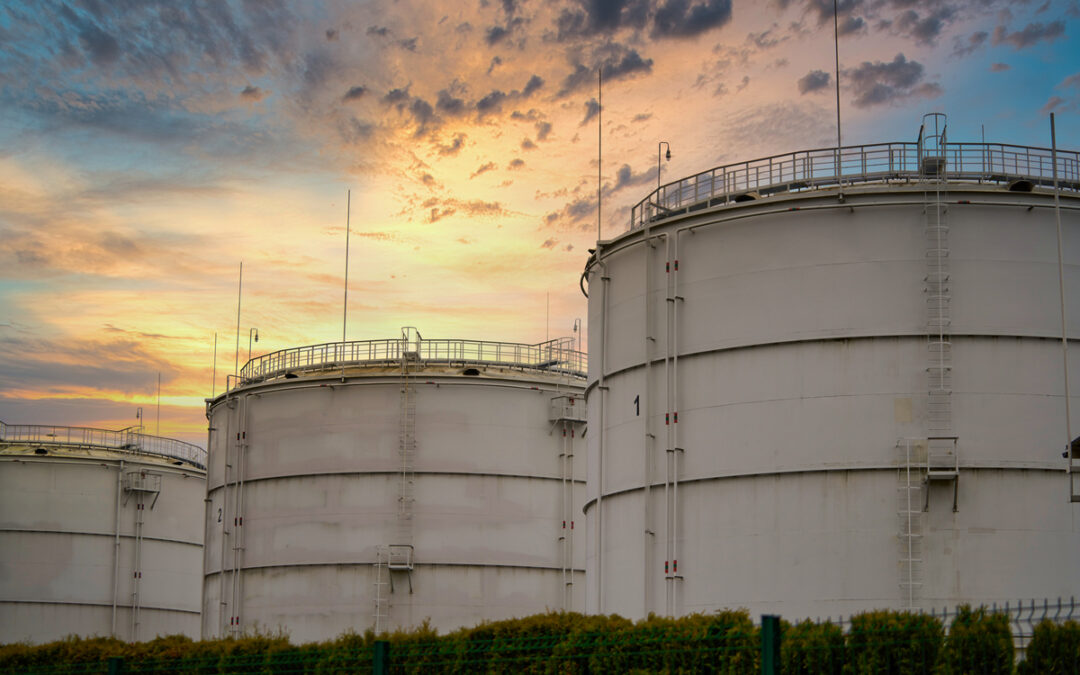Storage tanks play a key role in various industries, from oil and gas to chemical manufacturing and agriculture. Ensuring the integrity and safety of these tanks is crucial, as leaks or failures can lead to environmental damage and health hazards. By prioritizing compliance, industries can mitigate risks, avoid legal penalties, and contribute to a cleaner environment.
AST and UST Regulations for all Industries
Aboveground Storage Tanks (ASTs) are storage containers that are installed above the ground level. These tanks can vary in size and are commonly used for storing petroleum fuel products, chemicals, and water. Their regulatory requirements typically regard design, installation, maintenance, and spill prevention.
Underground Storage Tanks (USTs) are tanks that are buried beneath the ground to store petroleum products, chemicals, or hazardous substances. Resource Conservation and Recovery Act (RCRA) Subtitle I for underground storage tanks regulates to prevent leaks and protect groundwater. UST owners and operators must register their tanks, regularly monitor for leaks, implement measures to prevent releases, and demonstrate the financial ability to clean up any leaks.
While specific regulations can vary based on the type of industry and the materials stored, there are several common regulatory themes that apply broadly.
Permitting and Registration Requirements for Storage Tanks
Most industries require storage tank facilities to obtain permits or registrations from regulatory authorities. These documents authorize the operation of storage tanks and ensure that tanks are designed, constructed, and installed with structural integrity.
At a federal level, the EPA’s Spill Prevention, Control, and Countermeasure (SPCC) Rule requires facilities to develop a SPCC to prevent spills and outline response procedures. This applies to establishments that store oil or hazardous substances in aboveground tanks with a total capacity exceeding 1,320 gallons.
Many states and localities also have their own permitting and registration requirements for storage tanks. Above ground storage tank inspection requirements include registering the tank with the local agency and obtaining a permit before installing or repairing an AST. In addition to these requirements, USTs must report leak detection systems.
Essential Spill Control Protocols for Storage Tanks
Facilities must develop and implement spill prevention plans. Since early detection helps prevent contamination, regular monitoring and use of leak detection systems are essential to promptly identify leaks or abnormal tank conditions. This includes scheduled maintenance and inspection of tanks to assess structural integrity and corrosion levels.
Response procedures must also be in place to effectively manage them if they occur. This often involves containment systems, spill kits, and employee training in emergency response protocols.
Effective Waste Management for Storage Tanks
Proper management and disposal of waste materials generated from tank operations are essential to prevent contamination. All waste materials should be properly classified and labeled as hazardous or non-hazardous by OSHA. If the waste is hazardous, it can only be disposed of at a certified hazardous waste facility.
AST and UST Regulations for Specific Industries
Agriculture Regulatory Requirements
In the agriculture industry, storage tanks are essential for holding fertilizers, pesticides, liquid feeds, and fuel. While many of these substances are pivotal for agricultural operations, they can pose significant risks to public health if not properly managed.
Above ground storage tanks storing fertilizers and pesticides must comply with the Federal Insecticide, Fungicide, and Rodenticide Act (FIFRA). FIFRA regulates the registration, distribution, sale, and use of pesticides to protect human health and the environment. All pesticides must undergo a registration process evaluating the ingredients, intended use, and potential health and environmental effects. Pesticides must have detailed labels with usage instructions and safety precautions.
The American Society of Agricultural and Biological Engineers (ASABE) sets standards for the construction of storage facilities for fertilizers and pesticides. Tanks used for storing liquid fertilizers and pesticides often need to be constructed from materials that are resistant to corrosion and chemical reactions. In addition, specifications for ventilation systems are required to control air quality within the storage facility, preventing the buildup of potentially harmful fumes.
Oil and Gas Regulatory Requirements
Tanks used for storing petroleum products, or other chemicals inevitably produce sediment byproducts that accumulate at the bottom of storage tanks over time, consisting of residue and impurities. Managing these waste products is critical for maintaining a safe and sustainable operation.
The American Petroleum Institute (API) publishes recommended practices that set industry standards for the design, construction, operation, maintenance, and inspection of storage tanks in the oil and gas industry.
API 650 and API 620 are both standards developed by the API. API 650 is ideal for larger, atmospheric tanks storing liquids at high temperatures but minimal pressure, typically used in oil and gas. API 620 focuses on pressurized tanks for lower temperatures, suitable for liquefied gases.
Chemical Regulatory Requirements
Process Safety Management (PSM) is a framework that applies to facilities that handle large quantities of hazardous chemicals. It aims to prevent major accidents caused by the accidental release of toxic, flammable, explosive or reactive chemicals. It requires a comprehensive program that addresses various aspects of safety, including hazard identification, safe work practices, employee training, and emergency preparedness.
Hazard Communication (HAZCOM) is a set of regulations that ensure that workers understand the hazards associated with the chemicals they encounter in their workplaces. Under HAZCOM, every hazardous chemical container must have a label that clearly shows the dangers. Safety Data Sheets (SDSs) are also required to explain the chemical’s hazards, safe handling procedures, and first-aid steps.
Follow Above Ground Storage Tank Inspection Requirements With PALA
For over 30 years, PALA has specialized in the construction of aboveground storage tanks. Our team offers extensive experience in designing, fabricating, constructing, maintaining, and repairing tanks built according to API-650 and API-620 standards. We also handle AWWA tank construction and ASME repairs. Whether you require a new tank installation or repairs to an existing one, our skilled professionals are committed to completing projects according to standards.

